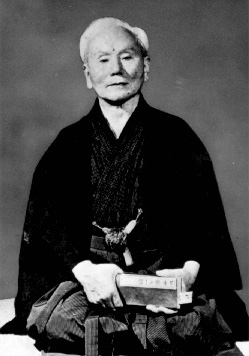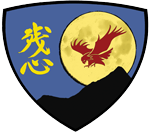Okinawan Origins

"Trying to sort through [the history of karate] for reliable facts is like trying to catch hold of clouds." Gichin Funikoshi, Karate-dō Nyūmon.
This is the history of karate and the founding of Hayabusa. Hayabusa is primarily an Okinawan karate school in the tradition of Gichin Funikoshi. While there are numerous written histories of Okinawa, the ancient origins of karate are largely unknown. This is because of the necessity for secrecy and the tradition of masters passing down knowledge to individual students. We do know how over the past 600 years karate has been tied to the cultural history of Okinawa and the influences from Japan and China. And from the records of the past 200 years we know some of the influence of great masters that formalized and developed modern karate.
The history of Hayabusa martial arts is rooted in Okinawan karate. Okinawa, an island south of Japan, was historically viewed by China and Japan as important for trade and was a melting pot for the cultures and martial arts of China, Japan and indigenous Okinawan.
In the 1400s the nation states of Okinawa were for the first time united under the rule of Sho Hashi. In order to rule over regions that were previously independent the government banned weapons for most people. With no access to weapons, the people sought ways of protecting themselves. Karate itself also had to be kept secret as the ruling parties feared its use as a weapon in the hands of the people.
Martial arts had already existed in Okinawa including native Okinawa te, and kenpo that had been adapted from China. It was practiced by the peasant fishermen and farmers as a way of protecting their families from armed bandits. Kata became a critical way of learning for individuals to develop their skill in secret between lessons. As did the integration of bo, sai, tonfa, nunchaku, and kama into self-defense techniques and kata. These farm tools were exempt from the weapons ban and could provide formidable defence against attackers with swords and spears.
In 1609 the Japanese state of Satsuma occupied Okinawa and set up an even more restrictive weapons ban. This time even the ruling class was affected and began to seek out empty hand defenses. This was a likely “catalyst to spur refinement of already existing techniques,” (Funakoshi Karate Do Nyumon).
Over time there would be an integration of the Japanese Samurai martial arts with Okinawan karate. The Samurai were soldiers who were dedicated to serving their master and protecting their territory. Their primary weapon was the katana, but in order to defeat other armored Samurai in close combat they also developed the martial arts of aiki-jutsu, and ju-jutsu. The Samurai lived by a code of honor called Bushido and followed the philosophies of Zen and Confucius. Their lives were highly structured with customs and etiquette. Knowing that on any day and at any time they could face death in the line of duty, they developed a mindful awareness of the beauty around them and found joy in art, nature, and grace. Many of these traditions are alive today in martial arts, including Hayabusa.
In 1868, during the Meiji period, the weapons ban in Okinawa was lifted, meaning that karate could be practiced openly. By this time though, secrecy was so ingrained in the masters that no written teachings or histories existed. It would be up to the next generation to formalize and spread the practice of karate and the person credited for leading that effort is Gichin Funakoshi.
From secret practice to imperial court
Gichin Funikoshi was born to a low-level Samurai family and was frail as a young boy. To boost his strength Funikoshi’s father asked karate master Azato to train his son.
As a young adult Funikoshi taught Chinese classics in Okinawan schools and taught karate to individuals and small groups on the side. Over the course of Funikoshi’s life there was an increasing awareness of Okinawan culture in Japan. In the early 1900’s Funikoshi merged his teaching and karate experience to help bring karate into Okinawan schools. He also began public demonstrations which caught the attention of the visiting Japanese crown prince. This earned Funikoshi an invitation to the Imperial Court in Tokyo to perform before the emperor.
An organized method
After his demonstration in Tokyo, Funikoshi was asked to stay and help set up schools. He travelled around mainland Japan for several years establishing karate curriculum at public schools and military academies.
After WWII karate was one of the few martial arts that was allowed to continue in occupied Japan. The practice of kata was viewed as a dance or cultural expression, while judo and kendo were outlawed by the occupying Allied forces. This allowed karate to spread beyond Japan to schools in the US and around the world.
Hayabusa History

“Martial Arts has always been the finest way for a person to achieve physical fitness, mental control and the self confidence they need to reach their full potential.”
Hanshi Judi Stiegler, founder of Hayabusa
Hanshi Stiegler grew up in Alfred, NY where she attended Alfred University obtaining her Bachelor of Arts Degree in Fine Arts and Master of Science Degree in Education. Looking for a fun way to stay physically fit, she tried a karate class and fell in love with martial arts. Women were not well received in karate at that time. For awhile she was the only woman in her classes and had to overcome the condescension of other students, even the Black Belts. “I was determined to achieve my black belt,” she explains, “Not just a ‘woman’s black belt’. I wanted to be as good as, even better than, the other students.”
She studied with several Black Belts in various schools and soon began winning both national and international championships. She also made appearances on TV and radio shows demonstrating her own skills as well as promoting martial arts in general.
In 1976 she founded Tatsu-Do Martial Arts and opened her first martial arts school. Later, she made the decision to leave her job as an art teacher in order to devote herself fully to teaching Martial Arts.
Hanshi Stiegler strongly insists that martial arts is not just kicks and punches—but respect, discipline, commitment, incentive, accountability, and honor. Always encouraging her students to “take the high moral road”, she believes that how you live your life is more important than how much money you make, where you live, or what job you have.
Hayabusa maintains the martial arts as an art form. This combines tradition with personal expression and a continual path for new challenges and growth. Students are held to high standards with a purpose to everything they do. Those who take to heart that Hayabusa is not just a self-defense but a way of life, are in the elite of the martial arts world.
